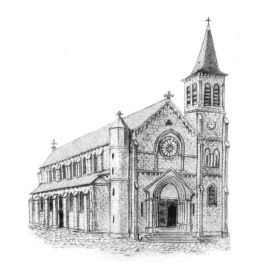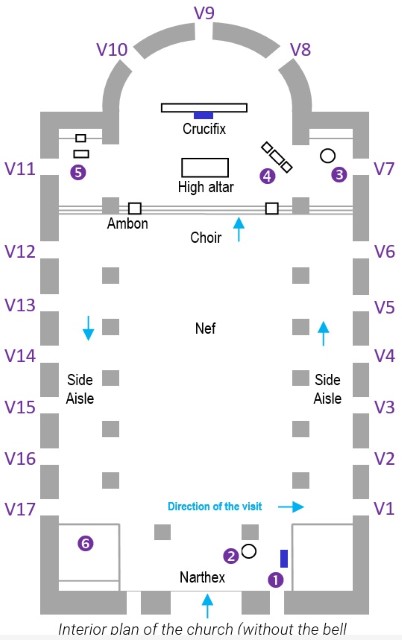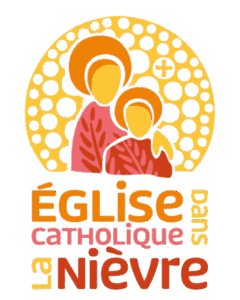Découverte de l’Église Saint-Romain (en)

In Château-Chinon, the Saint-Romain church welcomes you
Welcome to you who discover this sanctuary.
Although our church is not very old, its visit is nevertheless not without interest.
The objects it contains: crucifixes, statues, stained glass windows and baptismal fonts deserve to be looked at and contemplated.
Our church was started in 1894 according to the plans of Mr. PARTHIOT, architect, thanks to the initiative of Mr. Abbé DELOST, priest of Château-Chinon.
It was given over to worship from Christmas 1895; but it was not until 1900 that it was completely completed. It is built on a small hill in place of the old church; its plan is that of the Latin basilica and its style recalls the Gothic at its birth, the transition from the 12th to the 13th century.
Monsignor LELONG, then Bishop of Nevers, came to consecrate it on July 29, 1902. It is dedicated to Saint-Romain deacon.
Once through the door, the visitor enters the Narthex, which can be used to accommodate catechumens requesting baptism or penitents awaiting reconciliation. The Narthex then constitutes a symbolic threshold.
On the wall to the right, we can see a large oak Crucifixa (1) carved in a somewhat naive manner. It receives our first glance upon arriving and we will dedicate our last to it upon leaving. In the old church, it was placed low enough for us to kiss its feet, bloodied by the nail of the torture.
The holy water font (2), although undated, is clearly ancient. The holy water it contains reminds the Christian of his baptism(*).
Going up on the right, towards the choir, you can see a series of stained-glass windows (V1 to V7) dedicated to Saints and bearing the coat of arms of the donor family.:
- V1 – Saint-Ferdinand
- V2 – Saint-Vincent de Paul
- V3 – Saint-Henri
- V4 – Saint-Augustin (De Champs de Sa-lorge family)
- V5 – Sainte-Magdeleine (De Champs de Saint-Léger family)
- V6 – Marie et ses parents (D’Espeuilles family)
- V7 – The Holy Family

(*) – Baptism is the sacrament by which one enters the community of the disciples of the Risen Christ. In the early days of the Church, it was celebrated in the baptistery, often located outside the church. The baptized were immersed entirely in a basin or pool: this was baptism by immersion. This symbolized the crossing of the Red Sea by the Hebrews, with Moses. This act signified above all death to sin and the Resurrection, through Christ, to new life. Today, water is poured on the head of the one being baptized: this is baptism by effusion. A smaller tank is sufficient: this is the baptismal tank or fountain. The one in our church dates from the time of Louis XV.

V10 – Saint-Romain
In the Choir: stained glass windows of the large windows of the apse:
- On the right (V8): Saint Christopher (in Greek, He who carries Christ). He was the patron saint of the old priory whose monks served the parish of the town of Château-Chinon for a long time.
- In the center (V9): The Sacred Heart of Jesus with Sainte-Reine, patroness of Morvan, in a medallion.
- On the left (V10): Saint Romain, protector of the church and the parish.
The sanctuary: In the middle: the High Altar, which is the Table of the Eucharist. On the right: the Chair of Presidence (4) where the celebrant sits at certain moments of the Mass. On the left: the Ambo, the lectern from which the Holy Scriptures (Gospel) and the homily are proclaimed. These are the three essential pieces of furniture for the Liturgy of the Assembly of Christians. A beautiful ancient Christ presides in the center of the Choir.
On either side of the Choir is, on the right, the Chapel of the Baptismal Fonts (3) and on the left the Chapel of the Eucharistic Reserve (5). The latter is the privileged place of intimate prayer. A lamp burns there permanently to indicate the presence of the Blessed Sacrament in the Tabernacle. This, intended for the communion of the sick, is surmounted by a 16th century Virgin and Child, in marble, unfortunately broken and clumsily repaired. The stained-glass windows of the Choir are due to the talent of Mr Léon AVENET, master glassmaker in Paris. They were restored by the municipalities of Château-Chinon Ville and Château-Chinon Campagne between 1990 and 1995. The paintings were donated by Abbé LECOEUR, former chaplain of the Hospices de Paris and buried in the cemetery of Château-Chinon.
Going down the other aisle, we can still admire a series of stained-glass windows (from V11 to V17), also bearing the coats of arms of the donor families:
- V11 – Mary in the Glory of Heaven
- V12 – Apparition of Our Lady of Lourdes (Vatey family)
- V13 – Sainte-Reine, patroness of the Morvan (Colon family)
- V14 – Saint-Charles Borromée (d’Aboville family)
- V15 – Saint-Victor (Gautron du Coudray family)
- V16 – Saint-Andoche
- V17 – Saint-Louis of France
In the side aisles, the confessionals, left in place, may intrigue some non-Catholic visitors or those too young to have known their use. These booths, made of carved wood, allowed the penitent to privately confess his sins to his confessor and for the latter to reconcile him with God through absolution.
It is always possible to ask a priest to absolve you after hearing your confession

The chapel of Our Lady of Pity (6)
Above the altar, the wooden Pieta covered with grey wash comes from the Saint-Pierre church, now disappeared, of the former Capuchin convent.
Under the altar table, the stone altarpiece carved in high relief represents Christ appearing before Pilate.
At this location, a display offers candles that will burn in front of the Pieta. Lighting a candle is not a magical or superstitious gesture. Its symbolism is intended to be profound: the small flame signifies the rise of our prayer towards the divine light that triumphs over darkness and death
a. The inscription "INRI" placed at the top of the cross means "Jesus of Nazareth, King of the Jews". This is the reason for his condemnation by Pontius Pilate at the request of the enemies of Christ.

